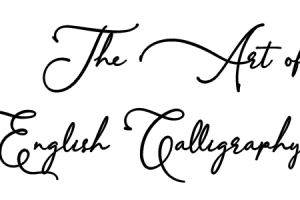What are Calligraphy Alphabets?
Calligraphy is the art of creating beautiful handwriting using various tools such as a pen, brush, or marker. Calligraphy alphabets are the various styles of writing alphabets that are used to create stunning lettering. Calligraphy alphabets for beginners are the simplest and most basic styles that are easy to learn and perfect for those who are new to calligraphy.
Popular Calligraphy Alphabets for Beginners
There are several popular calligraphy alphabets that are perfect for beginners. Here are some of the most popular ones:
1. Italic: The Italic alphabet is one of the simplest and most versatile calligraphy alphabets. It features slanted letters with clean, simple lines and is easy to learn.
2. Copperplate: Copperplate calligraphy is a classic style that is often used for formal invitations and announcements. It features graceful, flowing letters with thin upstrokes and thick downstrokes.
3. Gothic: Gothic calligraphy is a bold and dramatic style that is perfect for creating eye-catching lettering. It features thick, block-like letters with sharp edges and is often used for headlines and titles.
4. Uncial: Uncial calligraphy is a unique style that dates back to the 4th century. It features rounded, uppercase letters with minimal shading and is perfect for creating elegant and sophisticated lettering.
Tools Needed for Calligraphy
To create calligraphy alphabets, you will need a few basic tools. Here are the most essential ones:
1. Pen: A calligraphy pen is a special type of pen with a flat or angled tip that is used to create thin and thick lines.
2. Ink: Calligraphy ink is a specialized ink that is designed to work well with calligraphy pens. It is often available in a variety of colors.
3. Paper: Choose a high-quality paper that is smooth and doesn’t bleed. Some popular choices include Bristol board, tracing paper, or marker paper.
Basic Calligraphy Techniques for Beginners
Here are some basic techniques that every beginner should know when learning calligraphy alphabets:
1. Grip: Hold the pen at a 45-degree angle to the paper with a light grip.
2. Pressure: Apply pressure to the pen on downstrokes to create thick lines, and lift the pen on upstrokes to create thin lines.
3. Consistency: Practice writing each letter with consistent spacing and size.
4. Speed: Start slowly and gradually increase your speed as you become more comfortable with the lettering.
Practice Tips for Beginners
Practice is key to mastering calligraphy alphabets. Here are some tips to help you practice effectively:
1. Start with drills: Practice writing basic strokes and lines before moving on to letters and words.
2. Use guidelines: Draw light guidelines on your paper to help you keep your letters straight and even.
3. Practice regularly: Set aside time each day to practice your calligraphy skills.
4. Experiment with different tools: Try different pens, inks, and papers to find the ones that work best for you .
Common Mistakes to Avoid When Learning Calligraphy
Learning calligraphy can be challenging, especially for beginners. Here are some common mistakes to avoid:
1. Using the Wrong Tools: Using the wrong tools can make learning calligraphy more difficult. Make sure to use the right pen, ink, and paper to achieve the best results.
2. Rushing: Calligraphy requires patience and precision. Avoid rushing through your lettering, and take your time to ensure each stroke is carefully crafted.
3. Ignoring Consistency: Consistency is key in calligraphy. Pay attention to letter size, spacing, and shape to create uniform lettering.
4. Neglecting Practice: Practice is essential in learning calligraphy. Neglecting practice will hinder your progress and make it difficult to improve.
Benefits of Learning Calligraphy
There are several benefits to learning calligraphy, including:
1. Improving Handwriting: Calligraphy can help improve your handwriting by teaching you precision, consistency, and patience.
2. Boosting Creativity: Calligraphy allows you to express your creativity and create beautiful lettering that is unique to you.
3. Relieving Stress: Learning calligraphy can be a relaxing and meditative activity that can help reduce stress and anxiety.
Conclusion
Calligraphy alphabets for beginners are a great way to introduce yourself to the art of calligraphy. With the right tools and techniques, anyone can learn to create beautiful lettering. Remember to be patient, practice regularly, and avoid common mistakes to achieve the best results. Learning calligraphy can have many benefits, including improved handwriting, boosted creativity, and reduced stress. So why not give it a try and see where your calligraphy skills can take you?









Add Comment